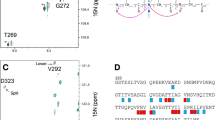Summary
Biosynthetically directed fractional incorporation of13C into proteins results in nonrandom13C-labeling patterns that can be investigated by analysis of the13C−13C scalar coupling fine structures in heteronuclear13C−1H or homonuclear13C−13C correlation experiments. Previously this approach was used for obtaining stereospecific1H and13C assignments of the diastereotopic methyl groups of valine and leucine. In the present paper we investigate to what extent the labeling patterns are characteristic for other individual amino acids or groups of amino acids, and can thus be used to support the1H spin-system identifications. Studies of the hydrolysates of fractionally13C-labeled proteins showed that the 59 aliphatic carbon positions in the 20 proteinogenic amino acids exhibit 16 different types of13C−13C coupling fine structures. These provide support for the assignment of the resonances of all methyl groups in a protein, which are otherwise often poorly resolved in homonuclear1H NMR spectra. In particular, besides the individual methyl assignments in Val and Leu, unambiguous distinctions are obtained between the methyl groups of Ala and Thr, and between the γ- and δ-methyl groups of Ile. In addition to the methyl resonances, the γCH2 groups of Glu and Gln can be uniquely assigned because of the large coupling constant with the δ-carbon, and the identification of most of the other spin systems can be supported on the basis of coupling patterns that are common to small groups of amino acid residues.
Similar content being viewed by others
Abbreviations
- NOE:
-
nuclear Overhauser effect
- fractional13C labeling:
-
biosynthetically directed fractional13C-labeling
- TOCSY:
-
total correlation spectroscopy
- ROESY:
-
rotating frame Overhauser enhancement spectroscopy
- [13C,1H]-COSY:
-
two-dimensional13C−1H correlation spectroscopy
- isotopomer:
-
isotope isomer
- P22 c2 repressor:
-
c2 repressor of the salmonella phage P22 consisting of a polypeptide chain with 216 residues
- P22 c2(1-76):
-
N-terminal domain of the P22 c2 repressor with residues 1–76
References
Bax, A. and Davies, D.G. (1985)J. Magn. Reson.,65, 355–360.
Bodenhausen, G. and Ruben, D. (1980)Chem. Phys. Lett.,69, 185–188.
Bothner-By, A., Stephens, R.L., Lee, J., Warren, C.D. and Jeanloz, R.W. (1984)J. Am. Chem. Soc.,106, 811–813.
Braunschweiler, L. and Ernst, R.R. (1983)J. Magn. Reson. 53, 521–528.
De Anda, J., Poteete, A.R. and Sauer, R.T. (1983)J. Biol. Chem.,258, 10536–10542.
DeMarco, A. and Wüthrich, K. (1976)J. Magn. Reson.,24, 201–204.
Driscoll, P.C., Gronenborn, A.M. and Clore, G.M. (1989)FEBS Lett.,243, 223–233.
Güntert, P., Braun, W., Billeter, M. and Wüthrich, K. (1989)J. Am. Chem. Soc.,111, 3997–4004.
Hansen, P.E. (1988)Prog. NMR Spectrosc. 20, 207–255.
Krivdin, L.B. and Kalabin, G.A. (1989)Prog. NMR Spectrosc.,21, 293–448.
Marion, D. and Wüthrich, K. (1983)Biochem. Biophys. Res. Commun.,113, 967–974.
Neidhardt, F.C. (1987)Escherichia coli and Salmonella typhimurium American Society for Microbiology, Washington, DC.
Neri, D., Szyperski, T., Otting, G., Senn, H. and Wüthrich, K. (1989)Biochemistry,28, 7510–7516.
Neri, D., Otting, G. and Wüthrich, K. (1990)Tetrahedron,46, 3287–3296.
Otting, G. (1987)Strukturermittlung an kleinen Proteinen mit NMR: Neue Methoden und Anwendungen am Beispiel der Cardiotoxine von Naja Mossambica Mossambica und des P222 Repressors. Ph. D. thesis No. 8314 ETH Zürich.
Otting, G. and Wüthrich, K. (1988)J. Magn. Reson. 76, 569–574.
Senn, H., Werner, B., Messerle, B.A., Weber, C., Traber, R. and Wüthrich, K. (1989)FEBS Lett.,249, 113–118.
Shaka, A.J., Keeler, J. and Freeman, R. (1983)J. Magn. Reson. 53, 313–340.
Szyperski, T., Leiting, B., Otting, G. and Wüthrich, K. (1992)Biochemistry, submitted.
Umbarger, H.E. (1978)Annu. Rev. Biochem. 47, 1127–1162.
Wüthrich, K. (1976)NMR in Biological Research: Peptides and Proteins, North-Holland, Amsterdam.
Wüthrich, K. (1983)Biopolymers 22, 131–138.
Wüthrich, K. (1986)NMR of Proteins and Nucleic Acids Wiley, New York.
Wüthrich, K., Szyperski, T., Leiting, B. and Otting, G. (1992)Proc. 1st Biennial International Conference on Amino Acid Research, Kyoto 1991, in press.
Author information
Authors and Affiliations
Rights and permissions
About this article
Cite this article
Szyperski, T., Neri, D., Leiting, B. et al. Support of1H NMR assignments in proteins by biosynthetically directed fractional13C-labeling. J Biomol NMR 2, 323–334 (1992). https://doi.org/10.1007/BF01874811
Received:
Accepted:
Issue Date:
DOI: https://doi.org/10.1007/BF01874811



